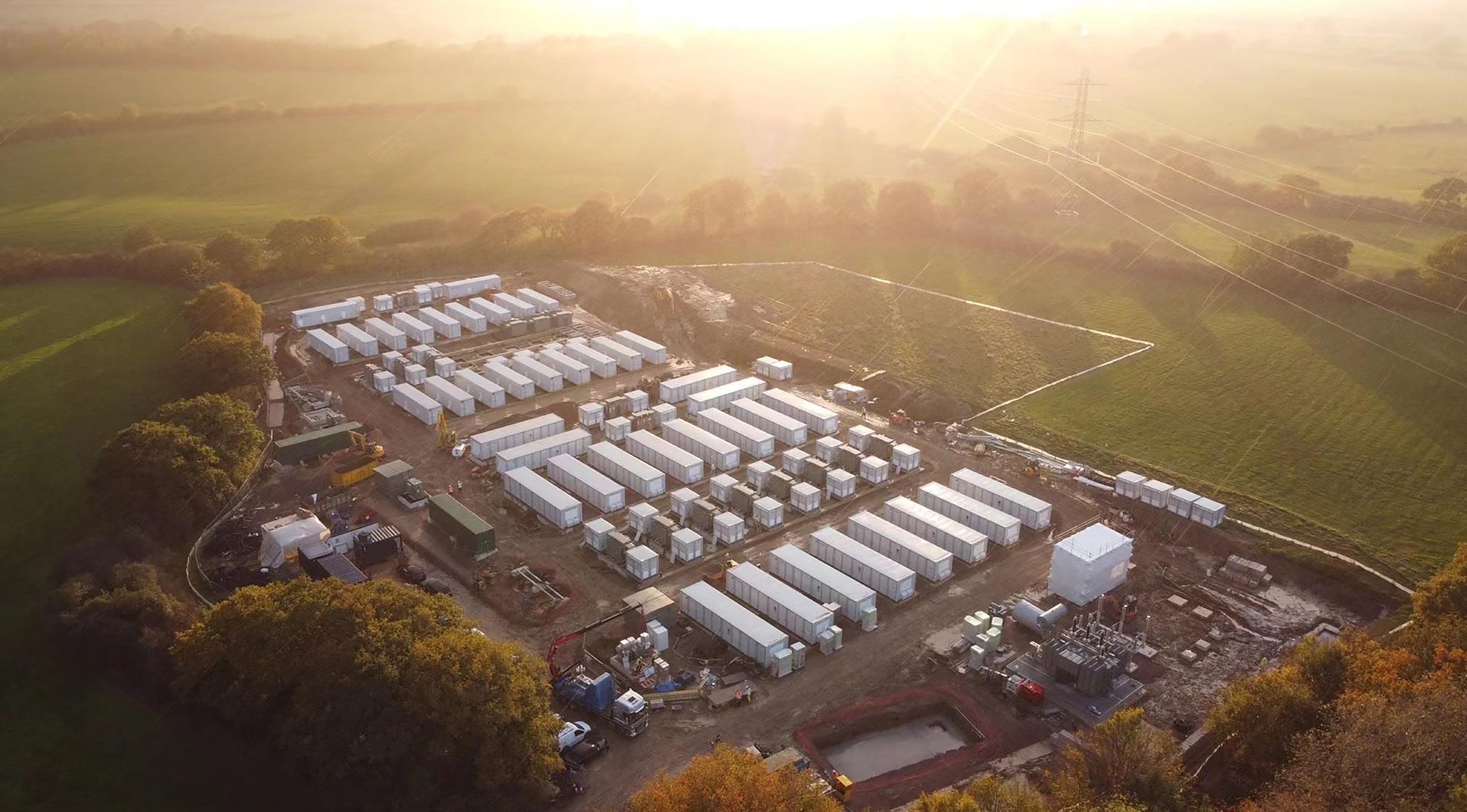
8 minute read
Enabling the energy transition
Richard Thwaites, Penso Power, UK, argues the case for swift energy storage deployment in the UK, with the aim of ensuring network resilience as the nation switches over to renewable energy.

The UK’s electricity system has undergone an impressive transformation in recent years as the nation works towards its net zero goals. Coal, which accounted for 60% of the UK’s electricity generated 30 years ago, barely registers in the nation’s generation mix most days and will be phased out completely by 2024. Wind has gone from less than 3% of the UK’s electricity supply only 10 years ago to providing almost one-quarter of electricity generated in 2020. While the nation has already seen very substantial change, there is a lot more to come. The future zero-carbon energy system forecast in the National Grid ESO (NGESO) Future Energy Scenarios includes a target of 40 GW of offshore wind by 2030 and more than 100 GW in some scenarios
by 2050 (the UK had 24.5 GW of operational wind assets in 2021). The nation also expects to see sizeable increases in generation from other renewable sources and substantial declines in gas-fired generation.
Adoption of electric vehicles, encouraged by the phasing out of the sale of new petrol and diesel vehicles by 2030, and the electrification of heating are expected to drive increases in electricity demand, although smart charging and the integration of thermal storage with electric heat will mitigate the impact on peak demand.
To keep pace with these changes, the way the electricity system is managed is also undergoing significant transformation. The evolution from centralised thermal generation that can be dispatched to match energy demand to a low-carbon system based on distributed, variable, and intermittent renewable generation creates some challenges. Energy storage, as a replacement for the flexibility previously provided by thermal generation to balance the electricity system, has become a critical enabler of the energy transition. The opportunity to deploy batteries on a large scale to support the energy transition in the UK was the motivation to launch and build the Penso Power business.
Preparing for the future electricity network
The forecast future electricity system includes green hydrogen, other forms of electricity storage, more interconnectors with neighbouring countries, and more intelligent energy use via demand-side response services. Batteries are expected to play a key role, providing a scalable solution to grid balancing requirements that is relatively unique in its ability to respond rapidly and proportionately to grid stress. NGESO forecasts an estimated need of 13 GW of energy storage by 2030 and up to 30 GW by 2050.
As the UK becomes more reliant on renewable generation, batteries can reduce renewable curtailment (the reduction of generation output to below what could have been produced) by storing energy during periods of excess generation. Batteries can also be used to firm supply by discharging to fill generation shortfalls. By doing this, batteries can substantially improve the capacity factor (average power output divided by rated peak power) of renewable generation assets, which means that more low-carbon renewable generation will be used within the electricity system. Batteries can also mitigate rapid output changes due to, for example, variable wind speeds to ensure stable power output.
Inertia in traditional power systems refers to the kinetic energy stored in large rotating generators that gives them the tendency to keep rotating. If a power plant fails, this stored energy can temporarily make up for power lost from a failed generator, perhaps only for a few seconds but sufficient time for mechanical systems to respond to a failure. Historically, inertia from conventional thermal generation was abundant and taken for granted in the planning and operation of the UK’s electricity system. The replacement of coal and gas-fired turbines with invertor-based generation sources such as solar and wind that do not synchronise with the grid in a way that provides inertia means that there is a need to find new ways to provide system stability.

Figure 1. The 100 MW Minety battery storage scheme near Swindon, Wiltshire, UK. Penso Power originated and developed Minety, which was Europe’s largest operational battery storage scheme when it entered commercial operation in 2021.
The provision of fast-response artificial inertia is a core function of batteries from a system operator’s point of view, and an electricity system that incorporates batteries to provide a range of grid services has less need for system inertia from other sources. The ability to respond within milliseconds means batteries can replace spinning reserve services, removing the need for fossil fuel-based generators to be running constantly to provide resilience. Removing the need for generators to maintain the extra headroom of spinning reserve means that, while they remain, they can be used more efficiently, lowering fuel costs and emissions.
Finding a balance
Short-term electricity trading takes place on two coupled power exchanges in Great Britain, EPEX and N2EX, offering intraday and day-ahead markets. The balancing mechanism (BM) is the system that NGESO uses to balance electricity supply and demand in near real-time in each half-hour trading period every day. These markets in combination offer the deepest and most liquid revenue opportunities available to battery owners such as Penso Power. Batteries participating in these markets generate revenues by arbitraging electricity price differences between different trading periods. In practice this means that batteries will charge during periods of least demand when the electricity price is low and discharge during periods of peak demand when prices are highest. As well as having a benefit of lowering peak electricity costs, this also means more (zero marginal cost) renewable generation will be stored for later use during the periods of highest demand removing the need to use as much expensive and polluting thermal generation.
As the UK system operator, NGESO has a licence obligation to maintain system frequency at 50 Hz plus or minus 1%. System frequency falls if electricity demand is greater than generation and rises if generation is greater than demand. Batteries provide a very fast-response solution to frequency regulation, helping to correct an imbalance in either direction and avoiding the need to dispatch thermal generation. Batteries currently provide these services via the Firm Frequency Response (FFR) and Dynamic Containment products and batteries will also participate in the Dynamic Moderation and Dynamic Regulation Frequency products (delivering energy for 30 min. and 60 min. respectively) when they are launched in March and April. The 100 MW (136 MWh) Minety Battery Storage site that Penso developed in Wiltshire, England is currently the largest participant in Dynamic Containment.
The UK’s distribution network operators (DNOs) are required to keep voltages on their networks within prescribed limits, set out in their licence conditions. Historically, the method DNOs use to manage voltages is tap changing, reducing, or increasing the number of windings in a transformer to change the voltage level either side of the transformer. This practice can cause problems at a transmission network level, often just passing up the most prevalent issue of ‘high volts’. A reactive power market, co-ordinated across NGESO and DNO networks, is being developed as a solution to these issues. Batteries will participate in this market to absorb and generate reactive power when needed to help alleviate capacity challenges associated with increased reliance on distributed generation.
Footroom typically means the ability to turn a generator down to balance the grid when there is a decrease in demand. Charging or discharging a battery to remove or add electricity from or into the system reduces the need for footroom from generators, helping NGESO to balance the grid at the lowest possible cost. Optional Downward Flexibility Management (ODFM) was introduced as a curtailment/footroom product in 2020 to help manage the impact of the unprecedented drop in demand caused by the first UK COVID-19 lockdown. In supporting the ODFM product, batteries demonstrated the value of fast-response, flexible assets in helping electricity systems adapt to changing and unexpected demands.
Supporting system resilience
Black Start, the mechanism to restore power to the transmission network in the unlikely event of a blackout, has historically depended on bilateral contracts with fossil fuel-based generators. Distributed Restart is a replacement for Black Start that uses distributed energy resources (DERs) such as wind, solar, hydro, and energy storage to provide this security. The growth of DERs has provided an opportunity to develop a different approach to system restoration that benefits from greater diversity of providers, improving resilience and increasing competition, leading to lower costs and lower carbon emissions. Distributed Restart works by forming distribution restoration zones (DRZs) comprised of multiple DERs performing the roles of anchor generator and top-up service providers. Batteries can perform multiple roles to support Distributed Restart.
A system operator uses constraint management when an electricity transmission network is unable to transmit power to the location of demand due to congestion at one or more parts of the network. NGESO’s Future Energy Scenarios predicts that changes in the volume and location of generation will lead to significant constraint costs if nothing is done. Constraints do not happen all the time, so it is usually cheaper to put contracts in place with batteries rather than upgrade the system. One of the reasons Penso Power is working with its partners at Luminous Energy to develop the 350 MW Hams Hall project in North Warwickshire, UK, is because it is located in a constraint management zone previously identified by NGESO.
Conclusion
In a nutshell, the deployment of large scale, fast-response energy storage will facilitate the transition to a low-carbon energy system. Batteries will play a key role in ensuring resilience of the UK’s electricity networks. They will enable system operators to balance the grid, and they can help defer or avoid the cost of expensive network upgrades. The use of energy storage will help allow more renewable generation in the UK’s electricity system, lowering emissions and reducing prices during periods of peak demand. The case for battery storage really could not be much stronger.

